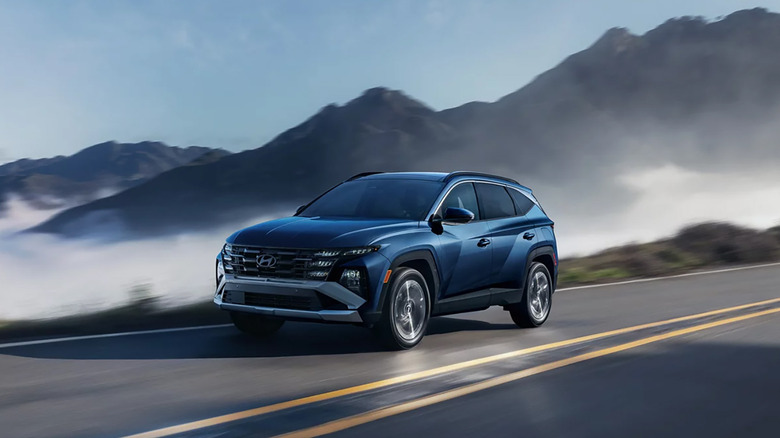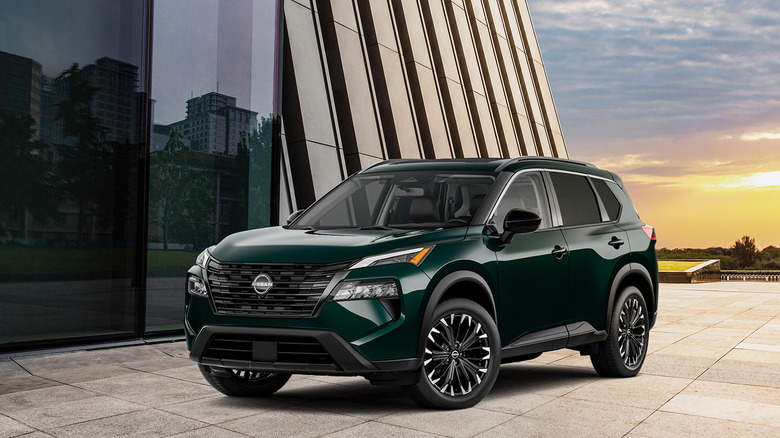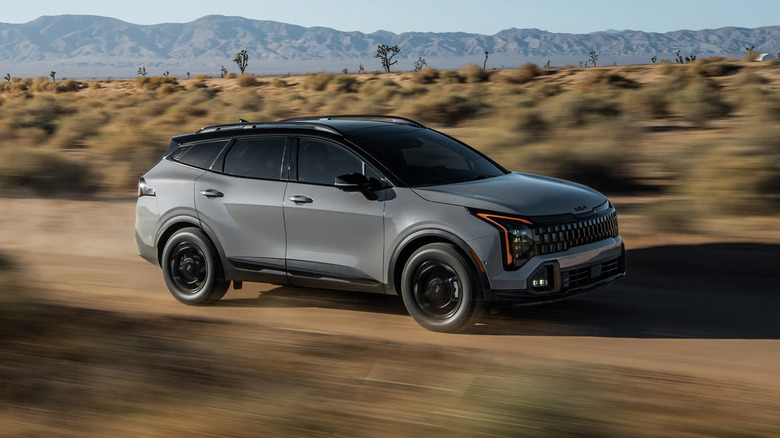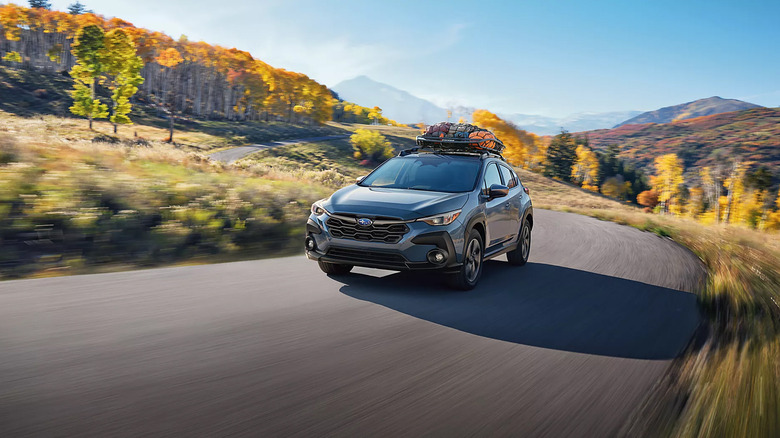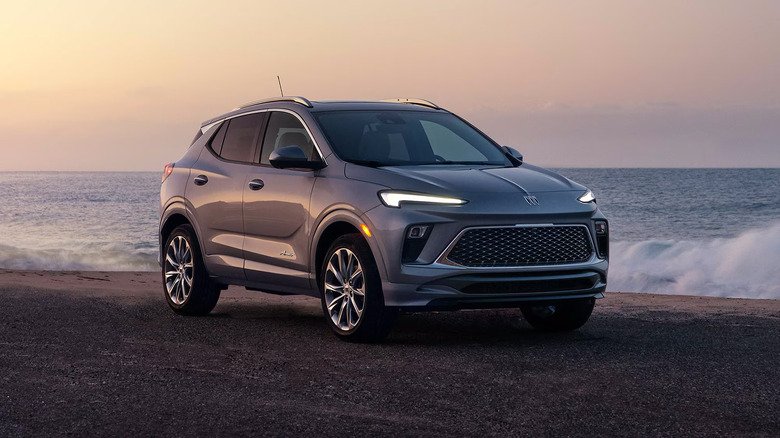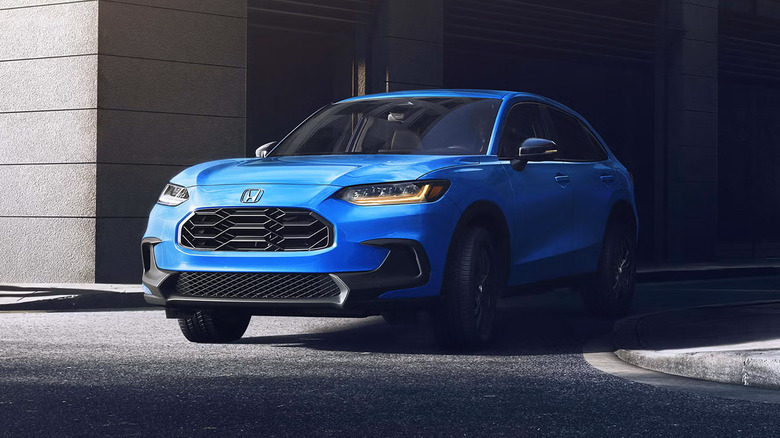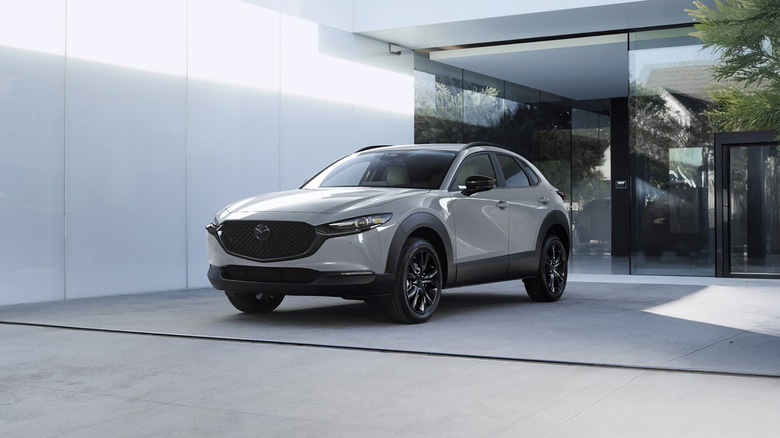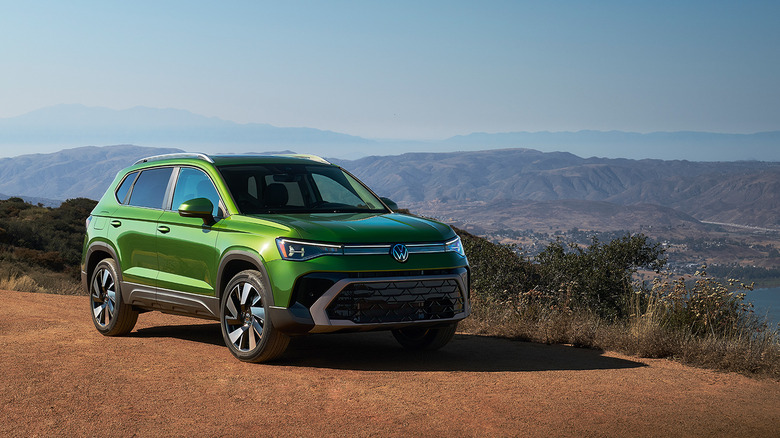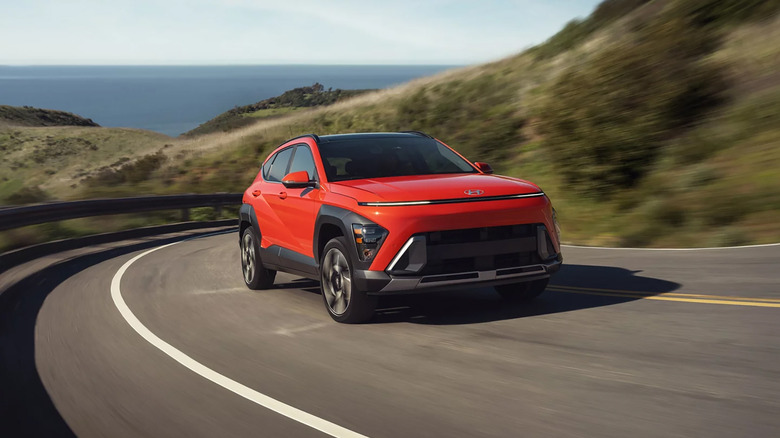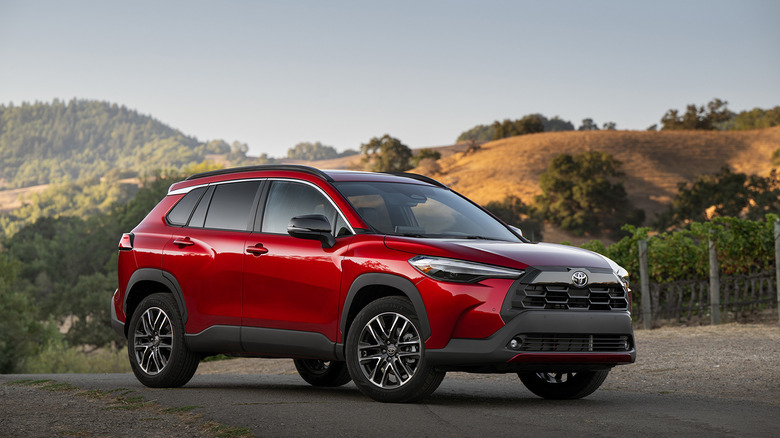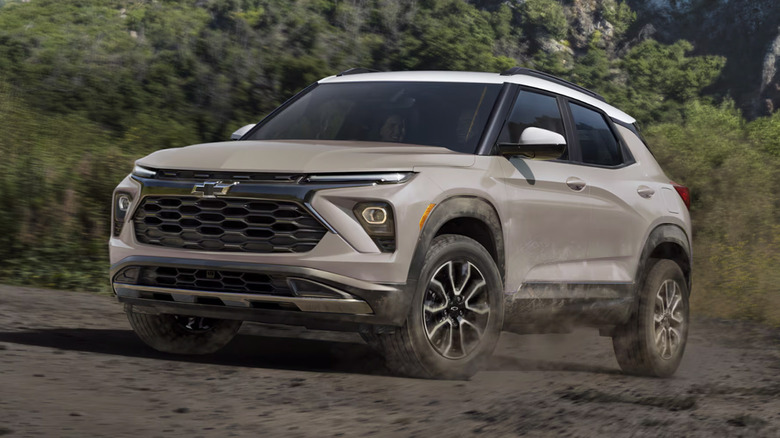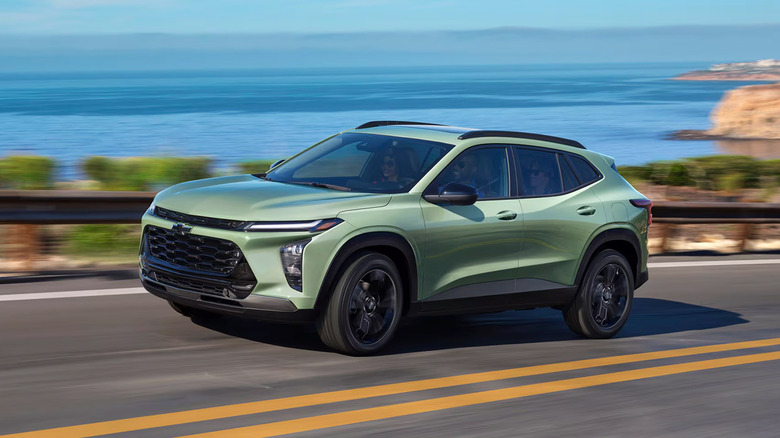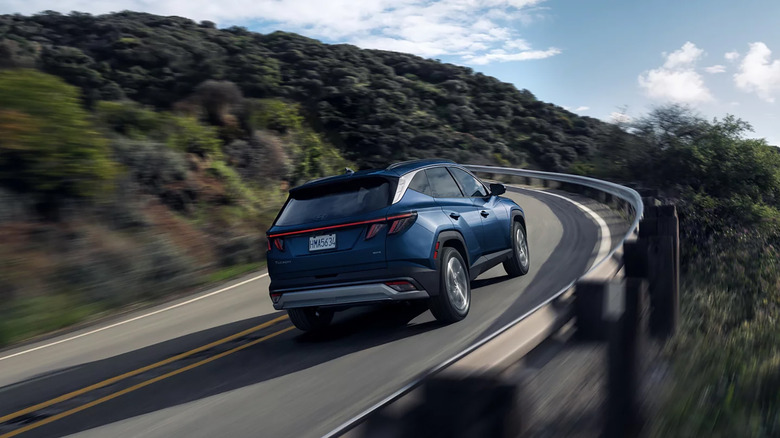11 More Affordable Alternatives To The Hyundai Tucson
Thanks to the ever-growing demand for the crossover, almost every major automaker selling its cars in the U.S. offers a solid lineup of SUVs to choose from. Particularly, the crossovers coming out of Asia are usually the ones setting the standards at the more affordable end of the segment. Hyundai is one of the brands competing at the very top of the industry's leading area, largely thanks to the compact Tucson, the best-selling SUV from the Korean automaker in 2025 so far.
Refreshed for the 2025 model year, there weren't many issues that we found with the Tucson during our review of the SUV. Powered by a 2.5L inline-four engine, you get a decent power output of 187 horsepower and 178 pound-feet of torque, which is there or thereabouts with its direct rivals. Inside, the Tucson's cargo space measures at 41.2 cubic feet behind the rear seats, a number that's tough to beat among the compact crossovers. There's also no shortage of tech inside the cabin, such as the now-standard 12.3-inch center touchscreen, allowing the Tucson to earn its $29,200 starting price tag.
While the 2026 Tucson isn't priced out of the ordinary for its type, a handful of manufacturers manage to offer equally compelling models for even less. Understandably, those priced notably below the Tucson won't be able to match it in every department, but the following 11 nameplates stand out in their own way within the jam-packed crossover scene.
2026 Nissan Rogue
Despite the brand's recent financial woes, Nissan's lineup is still pretty exhaustive, with the Rogue being the larger, more premium choice at the smaller end of the SUV scene. The Rogue received its most recent update in 2024, and moving in 2026, comes with plenty of standard features alongside its more impressive spec sheet compared to the Hyundai Tucson.
As expected, the Rogue falls within the usual territory when it comes to performance. It's motivated by a turbocharged 1.5L three-cylinder producing 201 horsepower and 225 pound-feet of torque — the latter being notably higher than its Korean rival. Despite having more power, the 2026 Rogue also outperforms the Tucson when it comes to efficiency. The EPA rates the base front-wheel drive trim at 33 MPG combined and the all-wheel drive at 31 MPG, with the latter even better than the Tucson's FWD rating.
The Tucson does offer slightly more cargo space, with the Rogue rated at 36.5 cubic feet behind the second row. But for a lower MSRP of $28,790 (with a $1,495 destination charge), the Nissan Rogue is a great option if you'd like some more power and better efficiency. Safety is another area worth mentioning for the Rogue, although it's not quite on the level of the Tucson in its base model.
2026 Kia Sportage
A model that's much closer to home for the Hyundai Tucson is the Kia Sportage. For quite some time now, Hyundai has donated quite a few of the core components of the Tucson to Kia, making the two nameplates incredibly similar on paper, but they differ from each other enough to not essentially be the same car with a different badge on it.
After all, Kia operates independently despite being owned by the largest Korean automaker, making the most of that freedom with the Sportage. The compact crossover was updated in 2026 with a redesigned front fascia, revised tail lights, and new tech features inside. Sharing the engine with Tucson, the 2026 Sportage produces 187 horsepower and 178 pound-feet of torque. Efficiency ratings also stay the same at 28 MPG in the base front-wheel drive trim.
The exterior design's futuristic tone now carries over into the cabin much more evidently, with the new steering wheel coming alongside the 12.3-inch touchscreen connected to the digital gauge cluster. This now puts the Sportage on the Tucson's level when it comes to infotainment tech, but still falls behind when it comes to standard safety equipment. You also won't get quite as much space inside the latest Sportage compared to the Tucson, but not by enough to write it off, particularly for its $28,690 MSRP. All models come with a $1,395 destination charge.
2025 Subaru Crosstrek
Subaru's lineup isn't as extensive as the likes of Hyundai, but that doesn't stop the brand from offering a selection of nameplates that come standard with features that others can't match for the price. For gas-only SUVs, there are only four to choose from, with the electric Solterra being the fifth in the overall SUV fleet in 2025. At the lowest end of the range, the Crosstrek is Subaru's compact crossover, pushing the function-first philosophy further than most as far as its capability goes.
A common feature that brand-new Subarus come with is standard all-wheel drive, carrying on the brand's deep-rooted legacy in rally with the modern lineup. The Crosstrek offers 9.3 inches of ground clearance and X-Mode, which made for one of SlashGear's favorite elements of the SUV during our review of the 2024 model. Under the hood, you get a 2.0L four-cylinder Boxer producing 152 horsepower and 145 pound-feet of torque. Not as close to the Tucson as other affordable alternatives, but the Premium trim comes with a more powerful 2.5L engine producing 182 horsepower and 178 pound-feet of torque.
Luckily, both of these trims are priced below the 2026 Tucson — the base trim comes in at $26,560 and the Premium trim at $27,180. The Tucson earns its higher MSRP with better standard technology and slightly more interior space, but for usage on other surfaces outside of tarmac, the Crosstrek is tough to beat.
2026 Buick Encore GX
A common trend with American manufacturers is turning most of their attention to the SUV segment, with the extra space being left for pickup trucks. While that's certainly a shame for the sedan segment, it does mean that there's plenty of choice for the more practical segment. Buick is GM's affordable luxury brand, focusing entirely on SUVs, and the manufacturer from Michigan has two models in production that come in below the Tucson. Still, the Encore GX is the better choice to compete with the Hyundai in terms of luxury and overall practicality. Priced at $26,495 (with a $1,795 destination charge), the Encore GX comes in well below the Tucson, which continues to be the case as you climb to the top-spec Avenir trim that sits at $31,600.
Looking at performance, this is where the Encore GX trails the Tucson most evidently, with its 1.2L three-cylinder engine producing 137 horsepower and 162 pound-feet of torque. The Sport Touring trim unlocks the 1.3L engine with 155 horsepower and 174 pound-feet of torque, but that's still below the Tucson. You should get better fuel economy in the Encore GX, though, being rated at 30 MPG in its most affordable front-wheel drive version. However, performance isn't the focus of the Encore GX — comfort is. While not a fully-fledged luxury SUV, you get synthetic leather seats as standard inside the well-equipped cabin, with safety technology good enough to rival most competitors on this list.
2026 Honda HR-V
Honda's main rival for the Hyundai Tucson has long since been the CR-V. However, with its starting price of $30,920, it's more expensive than quite a few of its direct competitors — the Tucson included. Luckily, if you want the premium feel that Honda goes for, the even smaller, more affordable HR-V can fill that gap. When comparing the HR-V directly to the Tucson, the latter takes the win in the majority of the key categories, but for an MSRP of $26,200, the 2026 HR-V is one of the best value-for-money purchases in the subcompact segment.
The powertrain for the HR-V is nothing to write home about. You get a 2.0L inline-four cylinder producing 158 horsepower and 138 pound-feet of torque, which is more powerful than the previous generation, but still not able to match the likes of the Tucson. This can be expected, however, with that job being given to the CR-V. Inside, however, the HR-V is more competitive, with larger SUVs thanks to using the Civic platform. Its 98.7 cubic feet of passenger space was something we noticed in our review of the 2023 model. For 2026, Honda has given all trims the nine-inch touchscreen display as standard, subsequently giving it wireless Apple CarPlay and Android Auto to boot.
2026 Mazda CX-30
A brand that seems to be getting more and more competitive each year is Mazda. By heavily investing in the SUV segment recently, the Japanese brand now offers a model for everyone, whether you want a compact crossover or a full-size EV. Regarding the nameplates at the former end of the segment, the CX-30 was released in 2020. It hasn't gone through any significant changes since then, but the 2026 model remains one of the most attractive for its price point, particularly if you want a bit more power compared to the likes of the HR-V.
Powered by a 2.5L four-cylinder engine, the 2026 CX-30 barely trails the Hyundai Tucson, producing 186 horsepower and an equal amount of torque per pound-foot. This is also another compact SUV to come with all-wheel drive as standard, enhancing its dynamics both on and off-road. Off-road traction assist features are standard to further help with that. Fuel economy ratings remain competitive despite being all-wheel drive, sitting at 27 MPG combined for the base 2.5 S trim. As for pricing, the base trim comes in at $25,975.
Inside, the Tucson does once again have the edge, coming with better standard tech features and more than double the CX-30's cargo space with the rear seats up. The Mazda offers 20.2 cubic feet behind the first row. The CX-30 isn't the best choice if practicality is paramount, but it's still a solid, affordable alternative to the Tucson if you want a more lively driving experience.
2025 Volkswagen Taos
Despite having one of the largest global presences in the automotive industry, Volkswagen's lineup is another that's considerably smaller than the likes of Hyundai. Only debuting for the 2022 model year in the U.S., the Taos has quickly become one of the core models in Volkswagen's in-house lineup, competing with the best of the best in the compact SUV segment for a very attractive price tag of just $25,495. At almost $4,000 cheaper than the newest Hyundai Tucson, the Taos won't beat it across the board, but it keeps well within reach.
The Taos has received its first major refresh for the 2025 model year, with benefits being seen throughout the crossover. Under the hood, the 1.5L four-cylinder TSI engine's power has been increased by 16 horsepower to 174 horsepower, with torque sitting at 184 pound-feet. You'll also get 31 MPG combined with the front-wheel drive trim, which is one of the best on this list by a margin. It's a common theme that the affordable alternatives to the Tucson can't keep up inside, however, with the Taos being another. Still, you get 27.9 cubic feet of cargo space behind the second row, as well as the renowned IQ.DRIVE assistance technology as standard.
2026 Hyundai Kona
The Tucson comes in well below the average new price for a car in 2025, but there's still another Hyundai SUV that's priced even lower that should definitely be considered if you want an SUV fresh out of the dealership for less. The Kona is the second-cheapest SUV on sale from the Korean brand in 2025, only beaten by the Venue in this regard. Priced at $25,350, the Kona understandably makes sacrifices compared to the Tucson to offer this price, but it remains another great value-for-money purchase in the segment.
Falling into the subcompact crossovers, the Kona is essentially a smaller version of the Tucson. For performance, the 2026 Kona is propelled by a 2.0L four-cylinder engine, producing 147 horsepower and 132 pound-feet of torque. While its power falls notably short, its estimated efficiency doesn't, with the EPA rating the front-wheel drive model at 31 MPG. This makes it an ideal SUV for urban living, even in its non-hybrid guise, combined with its smaller shell. If you want more power, though, the SEL Premium trim unlocks the 1.6L turbo engine that produces 190 horsepower, albeit with a $28,550 price tag.
Regarding its size, it'll be hard not to notice the difference between the two Hyundais, but the Kona's 25.5 cubic feet of cargo space behind the second row is more than other affordable alternatives. Thankfully, Hyundai includes the 12.3-inch center touchscreen as standard in the Kona, helping it feel well-equipped for its price tag.
2026 Toyota Corolla Cross
When it comes to the best affordable SUVs compared to the Hyundai Tucson, it's no surprise to see Toyota have one of the best offerings at the moment. Similar to Honda, Toyota's main rival to the Tucson has been the RAV4 ever since the mid-1990s. As expected, the price tags are incredibly close, leaving the smaller, yet equally compelling Corolla Cross as the next-best nameplate to compete with what the Hyundai can offer.
Given that the Corolla Cross offers most of the standout benefits that the base Corolla sedan does, the SUV variant of the nameplate comes with an array of features to justify its price point. Built on the same platform architecture as the sedan, the 2026 Corolla Cross also comes with the same engine, a 2.0L four-cylinder producing 169 horsepower and 151 pound-feet of torque. The best part about this engine, however, is the efficiency, capable of 32 MPG combined according to the EPA.
Cargo space comes in at 24 cubic feet, which, while not on the Tucson's level, is still ultra-competitive for an SUV of the Corolla Cross's size. You also get solid tech features inside the cabin, such as the new 10.5-inch touchscreen, all for a great starting price tag of $24,635 (with a $1,450 destination charge) for the 2026 model.
2026 Chevrolet Trailblazer
The Malibu's fate has already been set after being discontinued last year, leaving the Corvette as the only non-SUV or pickup truck to still feature in Chevrolet's lineup this year. No matter what type of SUV you're looking for, Chevrolet offers one at an ultra-competitive price tag compared to its rivals, particularly at the lower end of the market. Chevrolet is GM's most affordable brand across the board.
In 2021, the Trailblazer made its bold return to the lineup in its new compact form, following the discontinuation of the original model in 2009. Still in the same generation as the returning 2021 model, the Trailblazer got an update in 2024, focusing on the design and standard features, but the engine remained the same. You get a turbocharged 1.2L engine producing 137 horsepower as standard, but a more powerful turbocharged 1.3L engine increases that to 155 horsepower and 174 pound-feet of torque. Pricing for the two engines inside the base LS trim, including the $1,795 destination charge, is $24,995 and $25,390, respectively.
As for technology, the 2026 Trailblazer comes standard with a generous 11-inch center touchscreen paired with an eight-inch digital gauge display. Being another subcompact alternative to the Tucson, don't expect as much space inside, with the Trailblazer offering a cargo area of 25.3 cubic feet behind the second row. This is still better than some more expensive subcompact SUVs, however, making Chevy's second-cheapest model on sale one to consider.
2026 Chevrolet Trax
While the Trailblazer is the second-cheapest nameplate from Chevrolet in 2025, the Trax is the leas expensive. Before its major overhaul for the 2024 model year, the Trax wasn't the most appealing compared to its rivals, but the direction Chevrolet has taken this time around makes for what is easily one of the best bang-for-your-buck purchases if you go down the brand-new route.
Outside of a few new paint colors and packages, the Trax hasn't seen any major updates since its return. For performance, the 2026 Trax is powered by a turbocharged 1.2L three-cylinder, the same as the Trailblazer's standard engine. This produces 137 horsepower and 162 pound-feet of torque, which isn't quite comparable to the Tucson's output. For as little as $20,500 (with a $1,395 destination charge), though, that's not bad at all.
In our review of the 2025 model, the driving experience was one of the weaker aspects of the Trax, but for the money, it scored well in most of the other all-important areas. Up front, an eight-inch touchscreen comes as standard, with the 11-inch screen reserved for the higher trims. For cargo capacity, the Trax manages to hold on to the segment and even slightly edges out the Trailblazer with 25.6 cubic feet of space behind the second row. Once again, not on the level of the Tucson, but for almost $9,000 less than the Hyundai, Chevrolet manages to offer the essentials in a compact SUV for less than most.
Methodology
To select the models for this list, we first ensured that each SUV has a lower starting MSRP than the latest 2026 Hyundai Tucson. Then we checked that they offer competitive performance, efficiency, and standard features. We also looked at what the respective models offer that the Tucson doesn't. Hands-on experience was also crucial, whether it comes from SlashGear's own reviews or looking at what leading publications have to say if SlashGear hasn't tested the model. The SUVs have been arranged based on their starting MSRP.
